Why Is My Vizsla So Skinny? [MUST Know]
As a Vizsla owner, you might find yourself wondering why your canine companion appears to be skinnier than other dogs. While the lean physique is a natural characteristic of the breed, it’s important to ensure that being skinny isn’t an indicator of an underlying health issue. Knowing the ins and outs of your Vizsla’s dietary and health requirements can put your mind at ease and help you maintain your furry friend’s well-being.
Vizslas, as a breed, have a naturally lean and elegant appearance. Their slender bodies and thin coats are designed for endurance, agility, and an active lifestyle. So, it’s not unusual for a healthy Vizsla to appear skinnier than other dog breeds.
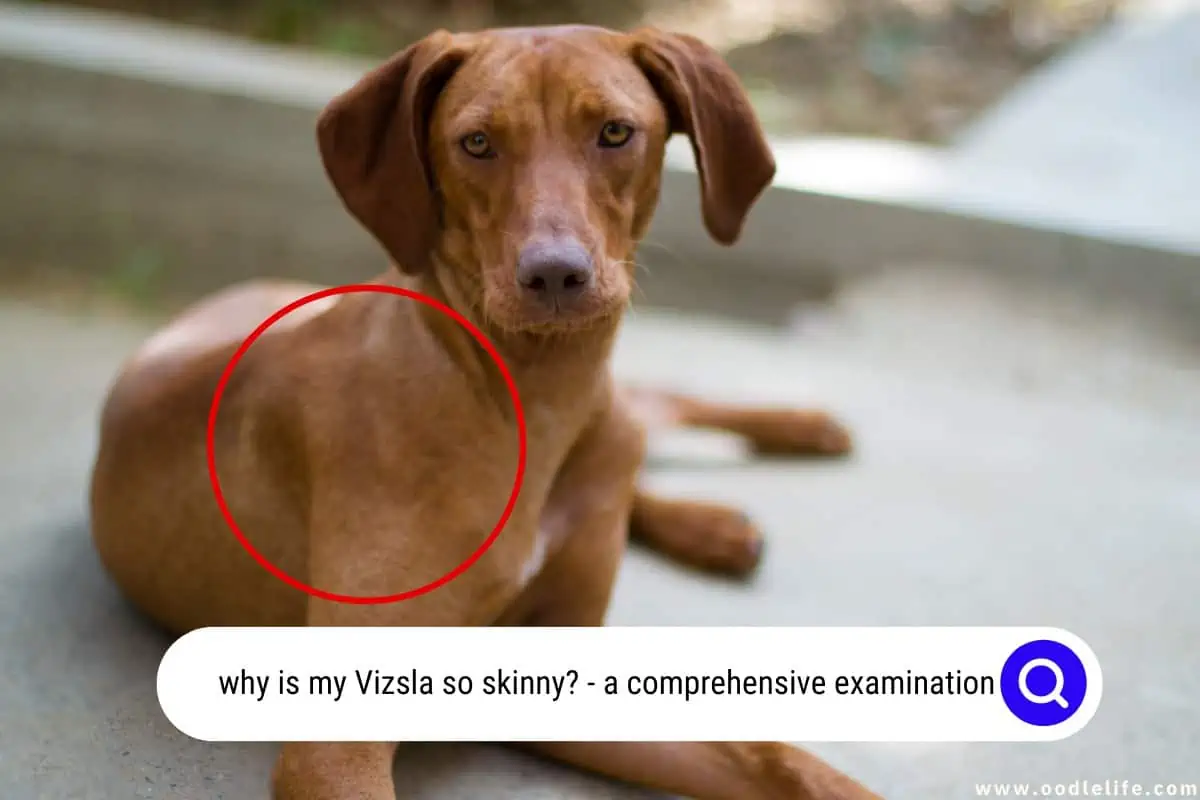
However, a Vizsla that is too skinny may be a cause for concern, and factors such as nutrition, exercise, and potential health issues should be considered. Understanding the balance between your Vizsla’s build and maintaining a healthy weight is essential to ensure a happy, thriving companion.
In determining whether your Vizsla is genuinely too thin or simply exhibiting its breed’s natural physique, it’s crucial to assess their body condition score (BCS). The BCS is a helpful tool in evaluating if your dog is maintaining a healthy weight or might require adjustments to their diet and lifestyle. With this in mind, take the time to observe, monitor, and understand your Vizsla’s body condition, and consult with your veterinarian when necessary, to keep them in optimal shape.
Why Vizslas Are Naturally Slim?
Vizslas are a medium-large breed of dog originating from Hungary. They are known for their lean, athletic bodies and elegant appearance. But why is your Vizsla so skinny? It’s mainly due to their genetics and natural physique.
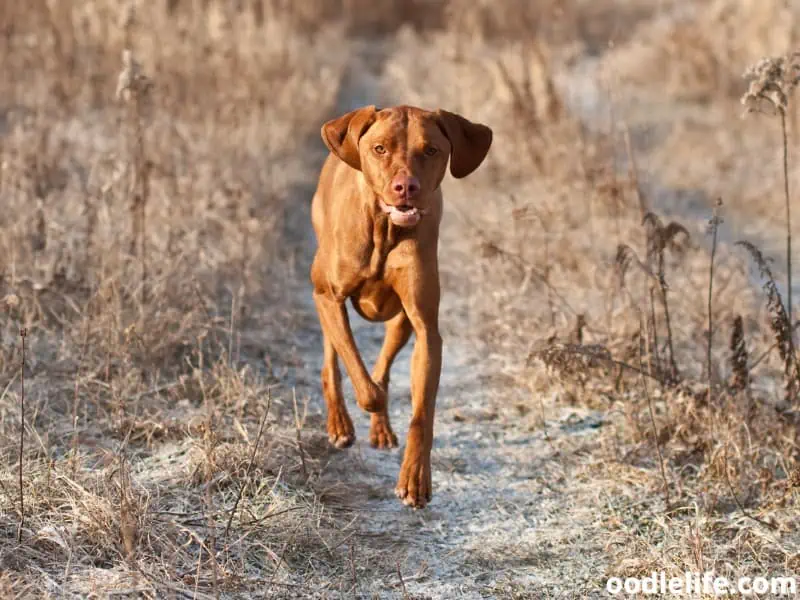
Vizslas have been bred as hunting dogs, which means they need to be agile and fast to chase game. This explains their slim build, as it allows them to move swiftly and efficiently. So, it’s not surprising to see a Vizsla with a thin, streamlined silhouette that resembles a racecar rather than a bulky SUV.
Another contributing factor is their size and height. Typically, Vizslas stand around 21-24 inches tall at the shoulder, which is considered medium-large for a dog breed. Their height and proportional frame further emphasize their slender appearance.
If you’re wondering whether your Vizsla is underweight, you can always check the breed standard charts for reference.
Those sleek coats make a difference too! Vizslas have short, dense, and close-fitting coats. This coat type provides minimal insulation, which means they don’t have thick fur to add bulk to their frames. That stylish coat also gives them an aerodynamic edge while hunting, so think of it as a couture jacket that’s always runway ready.
As the proud owner of a Vizsla, your role is to embrace your dog’s natural slim physique and ensure they maintain a healthy weight with proper nutrition and exercise. After all, genetics aside, a healthy diet and an active lifestyle will keep your Vizsla in top form. Just remember, when it comes to these graceful dogs, thin is in – but not too thin, of course!
In summary, a Vizsla’s skinny appearance is due to their breed characteristics, including their athletic nature, medium-large height, and close-fitting coat. So, if you’ve ever wondered why your Vizsla looks like a supermodel on four legs, now you know that it’s simply part of their genetic blueprint. Rest assured, your stylish dog is just following the latest canine fashion trend.
Health Factors Affecting Weight
If you’ve noticed your Vizsla looking skinny and underweight, a variety of health factors could be contributing to their weight loss. It’s essential to keep an eye on your dog’s overall condition to ensure they maintain a healthy weight.
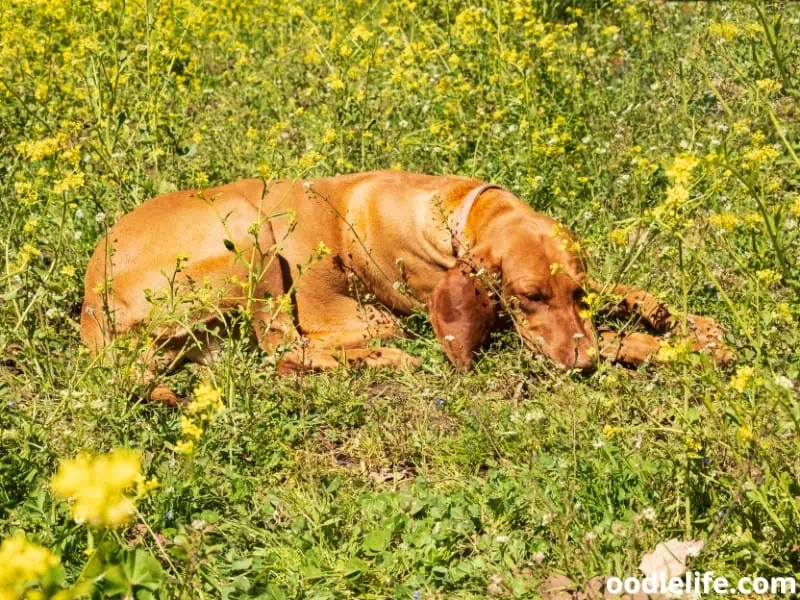
One possible explanation for your Vizsla being underweight might be an underlying health issue. For instance, polymyositis, a breed-specific muscle inflammation, has been reported in Hungarian Vizslas, potentially leading to weight loss and a thin body condition.
Sometimes, dogs may develop cancer, which can cause loss of appetite, fatigue, and general weight loss. Early detection and treatment are key to managing cancer in dogs, so it’s crucial to consult with your veterinarian if you suspect your Vizsla may have developed this health problem.
Another common health problem in Vizslas is hip dysplasia, a genetic condition where the hip joint doesn’t develop correctly. This may cause pain, lameness, and difficulty in maintaining a healthy weight due to reduced activity levels. Regular veterinary check-ups can help to monitor and manage hip dysplasia in your Vizsla.
If your Vizsla is otherwise healthy, underweight issues could be due to factors such as malnutrition, over-exercise, or insufficient calorie intake. In such cases, it’s important to provide your dog with an appropriate, high-quality diet and monitor their food intake.
Remember, it’s better to be proactive when it comes to your Vizsla’s weight and overall health. Always consult with your veterinarian if you have concerns about your dog’s body condition. After all, a healthy and happy Vizsla makes for a joyful owner!
Nutrition and Diet Considerations
One of the possible reasons for a skinny Vizsla is improper nutrition and diet. It is essential to ensure that your Vizsla receives a balanced diet, packed with calories, and high-quality nutrients. This will provide the energy needed for an active and healthy life.
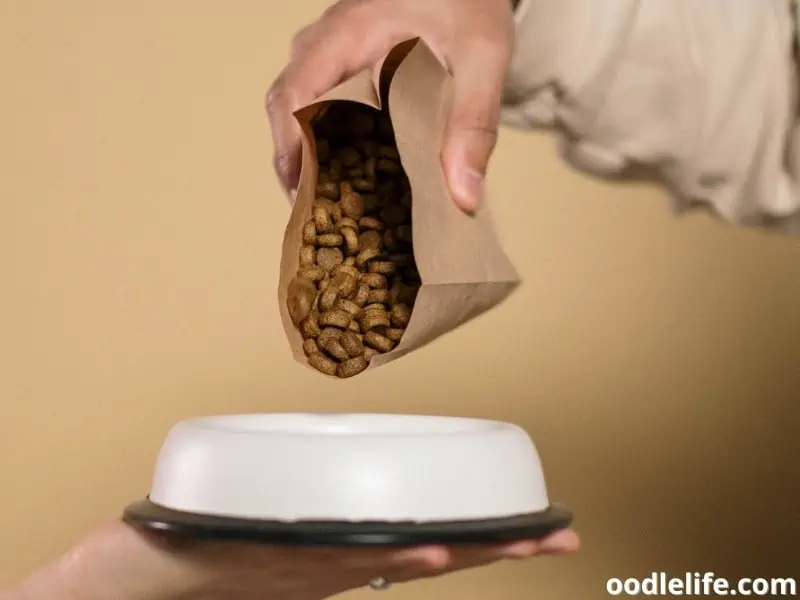
Make sure to pick a dog food specifically designed for Vizslas. The food should be rich in protein and fat, as these are essential nutrients for maintaining a healthy weight and strong muscles. For example, a diet with at least 25% protein and 15% fat is ideal.
Remember that every dog is unique, and their calorie requirements may vary based on their age, size, and activity level. A Vizsla’s appetite may fluctuate, so pay attention to your dog’s hunger cues. If your Vizsla consistently ignores their daily portion of food, it might be time to switch to a more appetizing dog food brand or flavor.
Here are some tips to keep in mind when it comes to your Vizsla’s diet:
- Choose a high-quality dog food: Opt for a reputable brand that uses quality ingredients and upholds strict manufacturing standards.
- Monitor calories: Adjust the portion of food based on the dog’s size, age, and activity level, and make sure they are consuming an appropriate number of calories per day.
- Consider supplements: If your dog’s diet is not providing enough essential nutrients, add supplements to help maintain a healthy weight and support overall well-being. Consult a veterinarian before incorporating any supplements into their diet.
- Ensure proper hydration: Along with nutrition, make sure your Vizsla is staying hydrated by providing constant access to fresh water.
By following a proper nutrition and diet plan, your Vizsla should begin to gain weight and maintain a healthier physique. Remember to be patient and consult a veterinarian if you are concerned about your dog’s weight or health issues.
Exercise and Activity Impact
The Hungarian Vizsla, known for its thin body and impressive stamina, is an energetic breed that requires ample exercise and stimulation. These dogs were initially bred for hunting, which means they have an innate need for physical activity to stay healthy. Their natural enthusiasm might be one reason for their slender appearance.
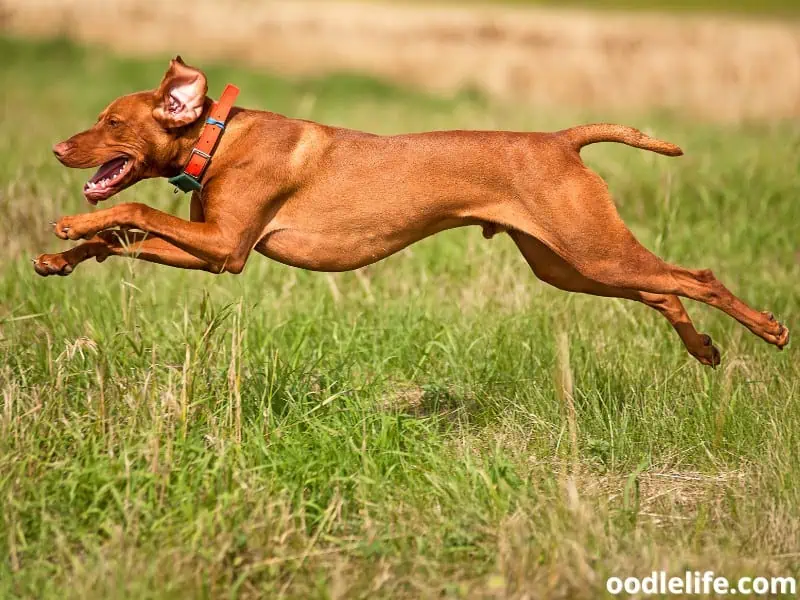
Vizslas have a high metabolism, allowing them to efficiently utilize the energy they consume. With plenty of exercise, they can burn calories quickly, maintaining their lean build. Regular physical activity also contributes to their overall behavioral health, as engaging in stimulating activities can prevent boredom and destructive behaviors.
A Vizsla’s hunting background also plays a part in their activity level. They were bred to be agile and quick on their feet, making them excellent runners and swimmers. Incorporating various activities like hiking, running, swimming, and fetch into their exercise routine can keep them both physically and mentally fit.
Remember that, much like humans, each Vizsla has its unique energy levels and exercise preferences. Pay attention to your dog’s signals – if they get too tired or seem disinterested in a particular activity, it’s okay to change things up or take breaks. It’s essential to find a routine that works well for both of you, ensuring that they stay happy and healthy while showcasing their impressive physique.
Finally, don’t forget to monitor your Vizsla’s diet alongside their exercise routine. Finding the right balance of nutrients and calories is crucial to maintain their slim, yet muscular build. After all, no one wants a Vizsla-turned-couch-potato!
Overall, the Vizsla breed’s natural inclination towards exercise and physical activity, combined with a swift metabolism and hunting background, largely contribute to their slender appearance. Just remember to keep an eye on their dietary needs and energy levels and cater to their unique preferences for activities, ensuring a healthy and happy dog!
Determining a Healthy Weight
Determining a healthy weight for your Vizsla may seem tricky at first, but it can be done with some knowledge and observation. Vizslas are naturally lean and muscular dogs, and their physique can sometimes give off an impression of being too skinny. However, this is not always the case, as a certain level of leanness is normal for the breed.

When assessing the weight of a Vizsla, it’s important to first consider its age. Puppies and young dogs may appear thinner as they are still growing and haven’t yet reached their mature size. As they mature, their muscles and girth will usually fill out, giving a more balanced appearance.
To evaluate your Vizsla’s weight, use the Body Condition Score (BCS) method as it is considered an excellent method to determine the ideal body condition. A score of 1-3 indicates that the dog is too thin, 4-5 is ideal, and 6-9 is overweight. Look for the visibility of ribs, waist, and abdominal tuck while assessing the BCS.
Here are some factors to consider when determining your Vizsla’s healthy weight:
- Muscularity: Your Vizsla should have a well-defined and toned musculature, but not to the point of being overly ripped or bulging. A muscular dog that is at its normal weight should still have some visible skin on top of the muscles.
- Waist: Check your dog’s waist from the top; it should be narrower than the chest. Also, from the side, the abdomen should tuck up towards the rear.
- Ribs: You should be able to feel the ribs when running your hands along the dog’s sides without pressing hard, but they should not be prominently visible at all times.
- Girth: The girth of your Vizsla should give an oval shape from the front, with the widest point at the chest, narrowing towards the abdomen.
If you’re still unsure about your Vizsla’s weight, consulting with a veterinarian is always a wise choice. They can provide guidance based on your dog’s physical examination and recommend any necessary changes in diet or exercise. Remember, a well-balanced and happy Vizsla is a healthy Vizsla.
When to Consult a Veterinarian?
If you’re worried about your Vizsla’s weight and wondering why they appear so skinny, it’s important to know when to consult a veterinarian. Generally, you should visit a vet if you notice any sudden or drastic changes in your dog’s weight or overall health.

A Vizsla might appear thin for various reasons, including insufficient nutrition, illness, or parasites. Your vet can help identify the underlying issue and recommend an appropriate plan of action. For example, they might suggest increasing your Vizsla’s food intake, treating them for parasites, or running additional tests for potential health concerns.
Remember that Body Condition Scoring is a better predictor of your dog’s health than just comparing it to breed weight ranges.
Keep an eye on your Vizsla’s behavior and energy levels, too. If your dog seems lethargic, uninterested in playing, or not eating well, these could be signs of a health problem requiring a vet’s attention.
In some cases, a skinny Vizsla might have an underlying health issue that isn’t immediately apparent. A regular check-up with your veterinarian is always a good idea, even if your dog seems healthy. Early detection of potential problems can help you address any concerns before they become more serious.
It’s not all doom and gloom, though – some Vizslas are just naturally lean and muscular. Just think of them as the canine embodiment of a marathon runner rather than a weightlifting enthusiast! So, don’t panic if your dog appears a bit thinner than others of the same breed.
Just keep an eye on their overall health, and consult your veterinarian when in doubt. That way, you can ensure your Vizsla remains the happy, active, and healthy companion you cherish.
Helping Your Vizsla Gain Weight
If you’re worried about your furry friend’s weight, fear not! There are several efforts you can make to help your Vizsla gain some healthy weight. Just follow these simple tips, and your pup will be on the road to a healthier version of itself in no time.
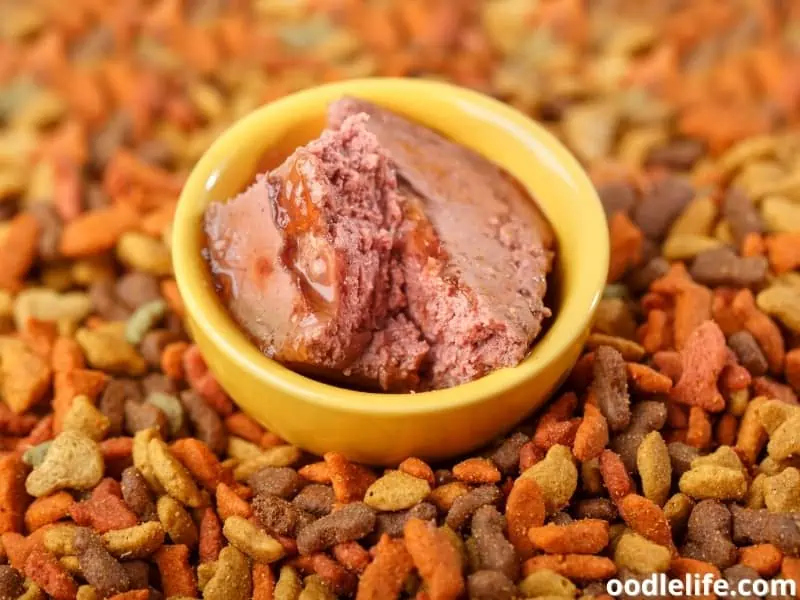
First, consider increasing the amount of high-quality dog food they consume. Make sure you’re feeding them age-appropriate meals. For instance, puppies need more frequent meals with higher protein content, while adult dogs might benefit from more energy-dense foods.
Consult with a veterinarian for personalized recommendations tailored to your Vizsla’s age and size.
Another method to help your Vizsla gain weight is by adding supplements or treats that are high in carbohydrates and healthy fats. You can mix some cooked brown rice, sweet potatoes, or oatmeal into their regular meals, as these are all rich sources of carbohydrates. Be sure to keep it wholesome and avoid sneaking in table scraps full of unhealthy fats – that’s a whole different kind of weight gain!
When adding treats to their diet, opt for nutrient-dense options like homemade dog biscuits or store-bought treats formulated for weight gain or muscle building. Make sure to monitor their intake, as too many treats can lead to unhealthy eating habits.
Don’t forget about the importance of exercise! Ensuring your Vizsla stays active will help them build muscle, contributing to healthy weight gain. Plan consistent, moderate exercise routines that incorporate both cardio and strength training.
Activities like hiking, swimming, and agility courses can keep your Vizsla engaged and excited about staying fit.
Lastly, be patient and consistent. Weight gain should be a gradual process, and it’s essential to stay on top of your Vizsla’s progress. Regularly consult with your veterinarian to ensure you’re meeting your dog’s nutritional needs without going overboard.
And always remember: Rome wasn’t built in a day, and neither are healthy, muscular Vizslas. Stick to your game plan, and watch as your slender pup transforms into a well-rounded, energetic Vizsla they were always meant to be!
Understanding Vizsla Behavior and Temperament
The Vizsla is a medium-sized dog originally from Hungary, known for its distinctive appearance and athletic build. These dogs are part of a group called working dogs, specifically, they are pointers. Despite their slender physique, Vizslas are pretty strong and agile, and their lean appearance is completely normal.
Vizslas have a very friendly and energetic temperament. They are known to be great companions, always eager to please their owners and engage in various outdoor activities. As working dogs, Vizslas are quite adept at hunting and retrieving game, making them highly prized by hunters and enthusiasts alike.
Their high energy levels also make them excellent candidates for agility training or other canine sports.
One notable aspect of Vizsla behavior is their propensity for separation anxiety. Due to their strong attachment to their humans, Vizslas may experience anxiety if left alone for extended periods. To address this, it is essential to provide adequate mental stimulation and exercise to help them cope with their natural sensitivity.
In summary, if you find your Vizsla to be seemingly “skinny,” don’t fret! This breed’s slender and athletic appearance is entirely natural and part of their charm. Embrace their unique build, focused work ethic, and affectionate nature, and you’ll have a loyal and energetic companion by your side.